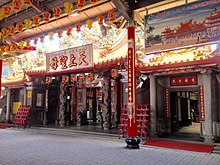Gangkou Temple
| Gangkou Temple | |
|---|---|
港口宮 | |
 Facade of the temple | |
| Religion | |
| Affiliation | Taoism |
| Deity | Mazu |
| Location | |
| Location | Dongshi, Chiayi |
| Country | Taiwan |
| Geographic coordinates | 23°29′45″N 120°11′09″E / 23.4957°N 120.1857°ECoordinates: 23°29′45″N 120°11′09″E / 23.4957°N 120.1857°E |
| Architecture | |
| Completed | 1684 |
| Direction of façade | Southeast |
Bengangkou Gangkou Temple (Chinese: 笨港口港口宮; pinyin: Bèngǎngkǒu Gǎngkǒu Gōng), alternatively known as Bengang Gangkou Temple,[1] is a temple located in Dongshi Township, Chiayi County, Taiwan. Located at the mouth of the Beigang River, the temple is dedicated to the sea goddess Mazu. "Bengangkou" means "entrance of Bengang", where Bengang refers to modern-day Beigang, Yunlin, which is located further up the Beigang River. "Gangkou" translates to "port".
History[]
Gangkou Temple was founded in 1684 (Kangxi 33) by a settler named Lin Kai (林楷). Lin Kai migrated from Meizhou Island, the birthplace of Mazu, and landed near the temple's current site. Due to the location's good feng shui, Lin Kai decided to build a simple temple here with the help of local residents, which he named "Tianhouxing Temple" (笨港口天后行宮). The temple was rebuilt into a brick structure in 1811. In 1871, a Qing Dynasty government official named Xie Long-guang (謝龍光) travelled from Guangzhou here and gifted the temple with a plaque, the temple was renamed to Gangkou Temple. Later, the temple was rebuilt two more times, in 1904 and 1948, into its current form.[2][3]
In 2005, temple officials announced that that they plan on building a larger temple on the site, citing the temple's cramped interior and damage from weather. A groundbreaking ceremony was held in August 2005 and the temple began fundraising. A temporary temple was also built nearby to house the Mazu statue. However, construction never started due to constant refusals from Mazu based on poe divination.[4] In 2020, the temple announced that Mazu agreed to renovating the temple instead.[3]
Traditions[]
Gangkou Temple hosts a major Ghost Festival event in the seventh month of the lunar calendar. This tradition dates back to 1845, where a flood on the Beigang River forced some people to migrate to from the north bank to the south bank, where they formed six villages. Therefore, every year, these residents hold a celebration at Gangkou Temple to pray for protection against further floods. This celebration is recognized by the Chiayi County Government as a cultural asset.[5][6]
References[]
- ^ "Journey for Regeneration". Taiwan Today (in Chinese). 1 August 2015. Retrieved 22 November 2020.
- ^ "笨港口港口宮". Dongshih Township Office (in Chinese). Retrieved 22 November 2020.
- ^ a b 蔡宗勳 (16 May 2020). "嘉義縣東石鄉「笨港口港口宮」決定進行大整修" (in Chinese). Liberty Times. Retrieved 22 November 2020.
- ^ 呂妍庭 (24 November 2017). "媽祖指示暫緩 港口宮重建喊卡" (in Chinese). China Times. Retrieved 22 November 2020.
- ^ "港口宮十一角頭中元祭". 嘉義縣文化觀光局 (in Chinese). 6 July 2018. Retrieved 22 November 2020.
- ^ 張誼 (12 April 2018). "港口宮十一角頭中元祭 登錄嘉義縣定民俗" (in Chinese). China Daily News. Retrieved 22 November 2020.
- 1684 establishments in Taiwan
- Religious buildings and structures completed in 1684
- Temples in Chiayi County
